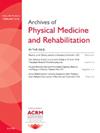Behavioral Fluctuation in Disorders of Consciousness: A Retrospective Analysis
IF 3.7
2区 医学
Q1 REHABILITATION
Archives of physical medicine and rehabilitation
Pub Date : 2025-10-01
DOI:10.1016/j.apmr.2025.03.038
引用次数: 0
Abstract
Objectives
To assess the frequency of behavioral fluctuations in patients with prolonged disorders of consciousness (DoC), characterize the stability of consciousness ratings, and characterize the stability of behavioral signs of consciousness.
Design
Prospective observational analysis.
Setting
Specialized DoC program in an inpatient rehabilitation facility and a long-term acute care hospital.
Participants
Patients in a vegetative state/unresponsive wakefulness state, minimally conscious state, and emerging from a minimally conscious state followed weekly by the Coma Recovery Scale-Revised (CRS-R) between 28 and 90days postinjury (N=241).
Main Outcome Measures
Change in CRS-R subscale scores and consciousness ratings.
Results
Behavioral fluctuation was observed in >80% of patients and was most common in the CRS-R motor subscale and least common in the communication subscale (83% and 54% of patients experienced ≥1 fluctuation over the 3wk study period, respectively, with a 1-point change observed most frequently). Among patients who were conscious at baseline assessment, 25% were subsequently rated as unconscious at least once. Localization to pain and object manipulation were the most stable signs of consciousness, recurring at least 3 times after the first occurrence in ≥97% of the sample. Reproducible command-following and intelligible verbalization were the least stable, recurring at least 3 times after the first occurrence in ≤27% of the sample.
Conclusions
Patients with prolonged DoC who undergo serial assessment demonstrate a high rate of fluctuation in behavioral signs of consciousness. These findings highlight that repeated assessments are essential in this population, both to capture the highest level of consciousness and to help distinguish spontaneous fluctuation from response to treatment in interventional studies.
意识障碍的行为波动:回顾性分析。
目的:评估延长性意识障碍(DoC)患者的行为波动频率,表征意识评分的稳定性,表征意识行为体征的稳定性。设计:前瞻性观察分析。环境:住院康复机构和长期急症护理医院的专业博士项目。参与者:在损伤后28至90天内,每周接受昏迷恢复量表-修订(CRS-R)随访的植物人状态/无反应清醒状态(VS/UWS)、最低意识状态和从MCS中出现的患者(N=241)。主要结果测量:CRS-R分量表得分和意识评分的变化。结果:超过80%的患者观察到行为波动,在CRS-R运动量表上最常见,在沟通量表上最不常见(83%和54%的患者在3周的研究期间分别经历≥1点的波动,其中1点的变化最常见)。在基线评估时意识清醒的患者中,25%随后被评为至少一次无意识。疼痛定位和物体操作是最稳定的意识体征,在≥97%的样本中,首次出现后至少复发3次。可重复的命令服从和可理解的言语表达是最不稳定的,在第一次出现后至少重复3次,在≤27%的样本中。结论:接受系列评估的长期DoC患者表现出较高的意识行为体征波动率。这些发现强调,在这一人群中,反复评估是必不可少的,既可以捕捉到最高水平的意识,也可以帮助区分干预研究中对治疗的自发波动和反应。
本文章由计算机程序翻译,如有差异,请以英文原文为准。
求助全文
约1分钟内获得全文
求助全文
来源期刊
CiteScore
6.20
自引率
4.70%
发文量
495
审稿时长
38 days
期刊介绍:
The Archives of Physical Medicine and Rehabilitation publishes original, peer-reviewed research and clinical reports on important trends and developments in physical medicine and rehabilitation and related fields. This international journal brings researchers and clinicians authoritative information on the therapeutic utilization of physical, behavioral and pharmaceutical agents in providing comprehensive care for individuals with chronic illness and disabilities.
Archives began publication in 1920, publishes monthly, and is the official journal of the American Congress of Rehabilitation Medicine. Its papers are cited more often than any other rehabilitation journal.

 求助内容:
求助内容: 应助结果提醒方式:
应助结果提醒方式:


